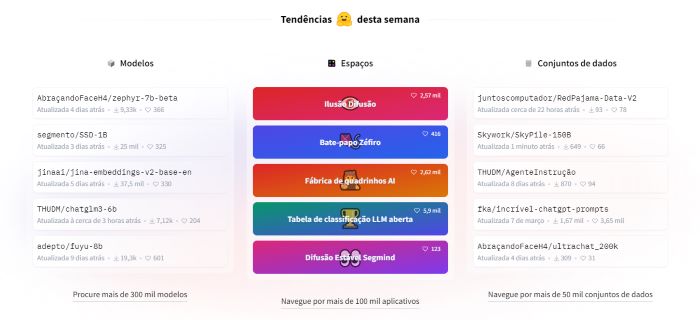Natural Language Processing (NLP) has become a constant and indispensable presence in our daily routine, from activating voice commands on our smartphones to instant language translation. our smartphones to instant language translation.
In this article, we'll explore what NLP is, its importance and how it has become integrated into our reality, transforming the way we communicate, research and interact with technology.
What is Natural Language Processing?
NLP represents an essential aspect of artificial intelligencewhich focuses on the interaction between computers and human language.
This field combines knowledge from computer science and computational linguistics to achieve its fundamental purpose: to enable computers to understand, interpret and generate text or speech in human language in a meaningful way.
This is achieved by applying machine learning algorithms and models, which enable machines to analyze and process written or spoken texts in a similar way to how humans do. We'll go into more detail below.

How does Natural Language Processing work?
NLP works through a set of techniques and algorithms. Below is a simplified overview of how it works.
Text pre-processing
Text pre-processing is the first step in preparing unstructured data for analysis. In addition to removing punctuation and transforming uppercase letters into lowercase for standardization, it is common to perform lemmatization, which reduces words to their base forms, such as transforming "correndo" into "correr".
This simplifies the text, reduces dimensionality and helps avoid duplications. In addition, the elimination of "stop words," such as articles and prepositions, is crucial in order to focus only on the most informative words, saving processing resources.
Once pre-processing is complete, the text data is ready for more advanced analysis, such as information extraction, sentiment analysis or even training machine learning models.
Tokenization
Tokenization plays a crucial role in NLP, as it breaks text into smaller parts, known as "tokens." These tokens can take various forms, depending on the task and context.
They can be individual words, complete sentences or even sub-words, as in compound or hyphenated words. This step is essential because it allows the text to be structured into elements that can be processed individually.
In other words, tokenization divides text into units that are easier to manipulate and analyze. This is essential for various NLP tasks, such as sentiment analysis, machine translation, text summarization and much more.
Morphological analysis
In morphological analysis, the structure of words is broken down to reveal their constituent elements. This involves identifying the roots, prefixes, suffixes and morphemes that make up each word in a text.
Understanding the morphology of words is fundamental to interpreting the meaning and grammar of sentences in a text. It also helps to identify semantic and syntactic relationships, contributing to a deeper and more accurate analysis of written language.
By unraveling the morphological structure of words, linguists and NLP systems are able to create richer and more detailed representations of language, which is essential for many text analysis and machine translation tasks.
Syntactic Analysis
Syntactic analysis goes beyond simply identifying words and tokens, delving into the relationships between these elements to uncover the grammatical structure of a sentence.
This means identifying the subject, which performs the action, the verb, which describes the action, the direct object, which receives the action, and other components that make up the structure of the sentence.
By performing a detailed syntactic analysis, NLP is able to understand not only the meaning of single words, but also how they combine to create a coherent message. This is crucial for tasks such as machine translation, text summarization, sentiment analysis and much more.
Semantic Analysis
Semantic analysis goes into the field of meaning and interpretation. It plays an essential role in understanding the context in which words and phrases are used.
This includes detecting synonyms, words that have similar meanings, and antonyms, words with opposite meanings, to capture the richness of human language.
In addition, semantic analysis is also involved in identifying word associations. This means understanding how certain words are related to each other in a specific context.
For example, in a sentiment analysis, it is important to determine whether a word is used positively or negatively based on the context, which is crucial for assessing the overall sentiment of a text.
Machine Learning
In addition to training models on large data sets, machine learning techniques machine learningtechniques such as neural networks allow NLP systems to learn from examples and identify complex patterns in words, phrases and documents.
These machine learning models are capable of performing advanced tasks, such as classifying documents into specific categories, detecting named entities (such as names of people or places) in text, analyzing sentiment, etc.
This combination of NLP and machine learning enables a diverse range of applications in areas ranging from customer service to academic research, making NLP a dynamic and constantly evolving discipline that plays a central role in our interaction with the digital world.
Specific tasks
NLP is not limited to general tasks, but also performs highly specialized tasks. These capabilities are made possible by the combination of machine learning models and NLP algorithms.
For example, named entity recognition is essential for identifying names of people, places and organizations in texts, and is valuable for extracting information from news stories and academic research.
Sentiment analysis is crucial to understanding opinions on products, services and topics, providing valuable insights for companies and decision-makers. Machine translation eliminates language barriers, allowing communication between different languages.
And the answers to questions can range from retrieving specific information in long documents to complex tasks such as answering medical questions based on extensive knowledge.
What is the Importance of Natural Language Processing?

The importance of NLP can be seen in a number of ways:
- Process and Analyze Large Volumes of Textual Data: NLP enables the efficient analysis and organization of extensive documents, making them searchable and extracting relevant information, speeding up information management.
- Analyzing Customer Feedback: NLP is vital for understanding how customers feel about products and services, contributing to informed decision-making and improvements in customer service.
- Task automation: automating tasks that involve natural language, such as chatbots and automatic responses, increases operational efficiency, saves time and resources.
- Answering Questions: it enables systems to answer questions about specific information, making the search for data faster and more effective.
- Advanced Machine Translation: online translators can translate languages more accurately and deliver grammatically correct results. And in addition to translating, the tools recognize the language based on the text entered and translate it automatically.
- Predictive Text on Smartphones: includes automatic correction, automatic completion and predictive text, which anticipate and improve your typing, getting better over time;
- Email filters: the system identifies whether emails belong to one of three categories (main, social or promotions) according to their content, this helps to reduce the number of messages by highlighting important and relevant emails.
- Search Prediction: refers to the ability of systems to understand user intent while typing or speaking, anticipating and suggesting relevant queries based on context and interaction history. Improving the efficiency of searches and interactions with virtual assistants.
Sectors Using Natural Language Processing
NLP is used in a variety of sectors to improve them. Here are some of them:
Information TechnologyTechnology companies use NLP to create virtual assistants that improve interaction with systems and services, making it easier to find information and solve problems;
Customer ServiceThe customer service sector employs NLP-based chatbots to automate answers to frequently asked questions, making customer support more efficient and accessible;
Health: NLP is instrumental in analyzing electronic medical records, helping doctors extract relevant information and make more informed clinical decisions;
Finance: Financial companies use NLP to detect fraudulent activity in transactions by analyzing text to identify suspicious patterns;
Marketing and Social Media: NLP is used to monitor public sentiment towards brands and campaigns, offering valuable insights. It is also used to personalize product and content recommendations, improving the customer experience.
Combining NLP Models on the Tess AI Platform

Have you ever thought of an AI that combines several NLP models on the same platform? Tess AI offers just that. It is the 1st Artificial Intelligence orchestrator in Brazil, developed by Pareto with a secure and robust system that connects it to the largest AIs in the world.
It integrates several respected NPL templates such as GPT, Dall-E, Midjourney, Ada and others. This opens up a world of possibilities, allowing you to automate a variety of day-to-day tasks with the help of the many templates available. Some examples include:
- Chat conversations;
- Audio and video transcription;
- Image generation;
- PDF analysis;
- Code creation;
- Video creation, among others.
The big difference is ease of use. To take advantage of all these capabilities, simply provide a topic or idea of what you want to produce, and our AI-based generator will take care of all the heavy lifting. In addition, Tess AI gives you the flexibility to create your own AI to solve specific tasks.
By using this technology as an ally, you will have the power to simplify and optimize your tasks efficiently, saving time and effort. It was created to make your activities more agile, productive and innovative, making the most of natural language processing.
Sign up for free and be part of this technological revolution! 🧑🚀
What Are the Approaches to Natural Language Processing?
The following are some of the most common approaches to NLP.
Supervised NLP
In this approach, NLP algorithms are trained with labeled data, which means that each input example is associated with an expected output.
This allows algorithms to learn to map inputs to outputs, making them effective in tasks such as text classification, where the goal is to categorize text into predefined classes, sentiment analysis to determine the emotions expressed in texts and machine translations.
Unsupervised NLP
This approach deals with unlabeled data, which means that the algorithms explore texts without the guidance of expected output examples. Instead, they identify hidden patterns and structures.
This approach is applied to tasks such as document clustering, where texts are organized into groups based on similarities, topic extraction to identify main themes in a set of documents and word association analysis to reveal relationships between terms in texts.
Natural Language Understanding
In this approach, NLP systems seek to understand human language by analyzing the structure, meaning and context of texts. This involves syntactic analysis to understand the grammatical structure of sentences, semantic analysis to extract meaning and pragmatic analysis to consider context.
Tasks included are question answering, where the system must understand the question and provide a relevant answer, and intent analysis, where the machine identifies what a user intends based on their query.
Natural Language Generation
In this approach, the focus is on creating text or speech in human language in a meaningful way.
This is used in tasks such as the automatic generation of text summaries, where a system condenses a long document into a shorter, more informative version, chatbots that generate answers in natural language to interact with users in a convincing way, etc.
Main Objectives of Natural Language Processing
In summary, the main objectives of NLP are:
- Improving Human Language Understanding: improving the ability of machines to understand and interpret human language;
- Increase Business Efficiency: reduce costs and automate tasks to make business operations more efficient;
- Increase Customer Satisfaction: provide more satisfying interactions between companies and customers through intelligent and personalized responses;
- Simplifying Communication: facilitate communication between businesses and consumers, making it less bureaucratic and more direct;
- Automate everyday tasks: Automate simple, repetitive tasks, freeing up human resources for more complex tasks.
Examples of NLP Libraries and Development Environments

Learn about some of the popular libraries and development environments in the NLP field. Each one has its own characteristics and applications. Below is a more concise summary:
HuggingFace: distributes pre-trained deep learning models and provides a toolkit in TensorFlow and PyTorch to evaluate the performance of these models on specific tasks.
TensorFlow and PyTorch: aboth are widely used frameworks for deep learningoffering support for various languages, with a primary focus on Python. They come with libraries of pre-built components and support high-performance infrastructure.
AllenNLP: High-level library for NLP, implemented in PyTorch and Python, with excellent documentation. It is suitable for tasks such as simple chatbots.
Spark NLP: Open source text processing library that supports Python, Java and Scala. It offers pre-trained models, pipelines and support for training customized models.
SpaCy: Open source library for NLP in Python, designed to process large volumes of text efficiently. It is known for its ease of use and ability to handle common NLP tasks.
These libraries and development environments are widely used in the NLP community to create natural language applications and models. The choice of which one to use will depend on the specific needs of the project and programming language preferences.
Conclusion
NLP is a technology that is already part of our daily lives and is playing an increasingly crucial role in the professional environment. From activating voice commands on our smartphones to optimizing market analysis and business decision-making.
The ability to understand and interpret human language is a competitive advantage that can automate tasks, save time and resources, and provide valuable insights from large volumes of unstructured data.
Staying abreast of the technological revolution will provide you with significant market opportunities. Be prepared for a smarter, more efficient future!
Related articles:
📱 Learn What the Internet of Things Is, How It Works and Examples
🤳 Deep Learning: What It Is, How It Works and Examples



